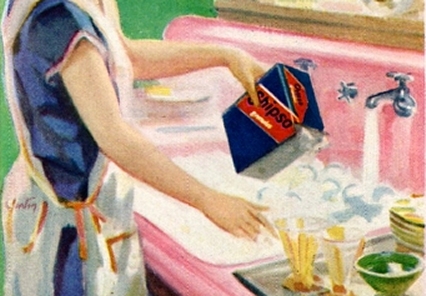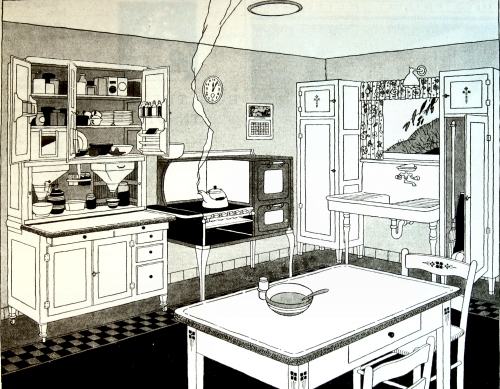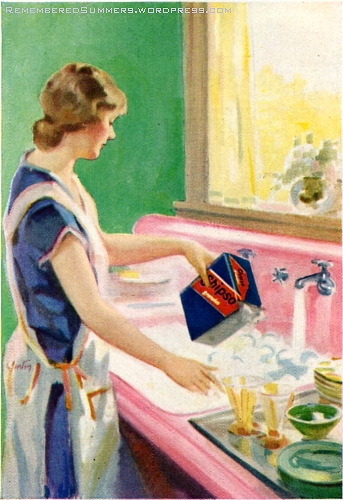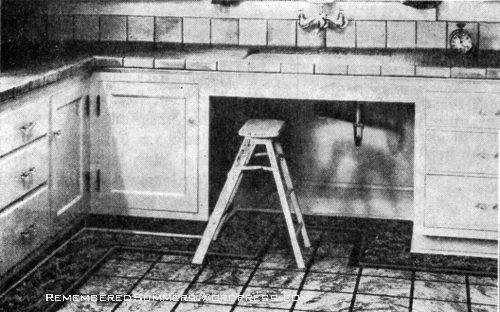Even those of us who remember the “Aztec Gold” and “Avocado” green kitchen appliances of the 1970s may be surprised by this pink kitchen sink from 1930. (The woman is still dressed in the styles of the 1920s; fashions don’t change overnight.)
I thought this might be a fluke, but an ad from a different company, one that manufactured wooden kitchen cabinets, shows the same green walls and pink sink combination. (And terrible lighting. This kitchen must have been pretty gloomy after dark.)
“Let Pine Make Your Kitchen Convenient” says this advertisement for Shevlin Pine, from the Shevlin, Carpenter, and Clarke Company; it appeared in Better Homes and Gardens magazine in February, 1930. Those odd devices under the cabinet are flour and sugar dispensers.

Flour and sugar dispensers, 1925. This is probably a Hoosier Cabinet, as advertised in Delineator magazine.
“The one room exclusively a woman’s, and so the kitchen should reflect cheer and charm as well as provide comfort and convenience” was the caption for this 1924 article, actually an advertisement.
When I had my kitchen repainted a few years ago, the painter/carpenter took one look at my built-in broom cupboard and said, “Most of my clients would kill for one of these!” Apparently most of her clients were so hung up on cherry cabinets, marble counter tops, and stainless steel appliances that they forgot to plan storage room for mops, brooms, dusters and vacuum cleaners. Not so, in this 1925 “dream kitchen.”
The Kitchen Sink
There was a school of art known as “kitchen sink realism;” my memory of our friends’ kitchens, installed during the 1920s and thirties and still in use in the forties, was not of stacks of dirty dishes but of a big hole — instead of cabinet doors — under the sink, sometimes concealed by a cheery cloth curtain, and sometimes just left empty for ease of reaching the garbage pail.
It was also a good place to store a step ladder or kitchen stool, as Little Red Chair points out in her charming “1920s Kitchen Tour.” Better Homes and Gardens magazine featured this “device for holding and draining moist garbage” in a page of useful gadgets in April 1930:
“It hangs beneath the sink, beside a catch-all for soaps and brushes. These utensils come in pleasing colors.” Very attractive, I’m sure. At least that sink has a faucet that allows you to mix hot and cold water; many didn’t:

This pink sink has separate faucets for hot and cold water; one is hidden by the soap box. It was easy to scald your hands, but an improvement over no hot water tap at all.
There were tremendous changes in kitchen design between 1924 and 1937.
“How to Equip the Modern Kitchen,” from an ad for Hoosier Cabinets, 1924:

“How to Equip the Modern Kitchen,” March 1924. Delineator magazine. The plumbing under the sink is exposed.
Thirteen years later, this ad for the Whitehead Planned Kitchen also featured purchased cabinets, instead of built-ins, but the Whitehead Steel wall and base cabinets could be permanently linked by stainless steel countertops and backsplash:

Whitehead Enameled Steel Cabinets; ad from The Delineator, April 1937. There’s an electric range, and a Westinghouse dishwasher right of the sink, but now there’s no place to put the kitchen stool. Win some, lose some!
This “moderne” kitchen had a wall of glass bricks and a louvered window (with no old-fashioned curtains.) And that un-lovely view of the U-bend under the sink has been replaced by a custom cabinet with a built-in garbage can:

“This refuse container is attached inside sink door. Provides for the bag system of disposal.” Whitehead ad, April 1937.
The streamlined kitchen below was described in an editorial article in Woman’s Home Companion, October 1937. The “noiseless counter tops” are linoleum, like the floor (they were certainly cheaper and lighter than modern countertops); “Soffit lights under the wall cabinets illuminate every working surface, with a central fixture for general lighting.” [Too bad there’s no light over the sink at nightime. Didn’t they wash dishes after dinner?]
There are three work areas: sink and refrigerator, left, and a work counter, right, are shown. The stove, with its flanking countertops and floor cabinets, would be behind you in this view. One work area is that countertop with room to sit while you work. These cabinets also seem to be pre-fab enameled metal. (Ikea didn’t invent the piece-by-piece kitchen. Hoosier cabinets were free-standing, too.) The wall cabinet to the left of the sink has a perforated door to give air circulation to the ever-present garbage pail.
I certainly recognize that kitchen color combination of yellow and red plus black, and those triangular display shelves from my childhood. My parents’ friend “Aunt” Lillian had them — decorated with Fiestaware pitchers and her collection of colorful, souvenir salt and pepper shakers; but my favorite thing in her kitchen was a black cat clock that rolled its eyes and twitched its tail. Sometimes having a sense of humor is better than having impeccable good taste!
To read about a more primitive kitchen from 1949, click here.








